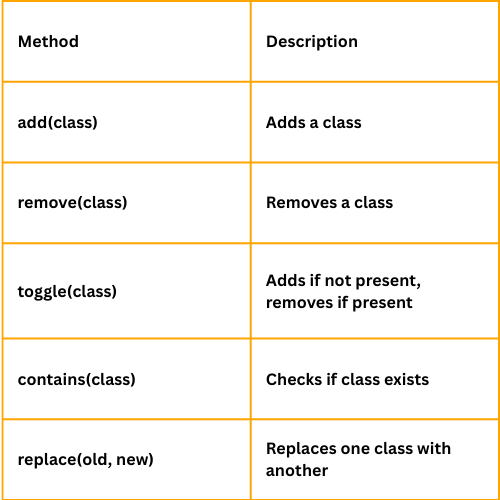
Change HTML Classes in JS
1. className
This is the older and simpler way to get or set the entire list of classes on an element.
Example():-
Adds a node to the end of a parent element.
<div id="box" class="red"></div>
const box = document.getElementById('box');
// Get the current class
console.log(box.className); // "red"
// Change the class completely
box.className = 'blue';
Warning:
Overwrites all classes. If your element has multiple classes, they'll all be replaced.
Good for simple use cases, but not ideal when you want to modify just one class without affecting others.
2. classList
This is the newer and more powerful way to get or set individual classes on an element. classList is a property that gives you methods to add, remove, toggle, and check for specific classes.

Example():-
<div id="box" class="red"></div>
<script>
const box = document.getElementById('box');
// Add a class
box.classList.add('shadow');
// Remove a class
box.classList.remove('red');
// Toggle a class
box.classList.toggle('hidden');
// Check if it has a class
if (box.classList.contains('blue')) {
console.log('Box is blue!');
}
// Replace a class
box.classList.replace('shadow', 'glow');
</script>
Project: Light/Dark Mode Toggle using JS
Below is a simple example of how you can use classList to create a light/dark mode toggle using JavaScript.
Features :-
A button toggles between Day Mode and Night Mode.
CSS classes change dynamically using classList.
Clean, minimal layout.
<!DOCTYPE html>
<html lang="en">
<head>
<meta charset="UTF-8" />
<meta name="viewport" content="width=device-width, initial-scale=1.0"/>
<title>Day/Night Mode Toggle</title>
<style>
/* Base styling */
body {
margin: 0;
padding: 0;
font-family: Arial, sans-serif;
transition: background-color 0.3s, color 0.3s;
}
.container {
height: 100vh;
display: flex;
flex-direction: column;
align-items: center;
justify-content: center;
}
button {
padding: 10px 20px;
font-size: 16px;
cursor: pointer;
margin-top: 20px;
border: none;
border-radius: 5px;
}
/* Light mode */
.light-mode {
background-color: #f0f0f0;
color: #333;
}
.light-mode button {
background-color: #333;
color: white;
}
/* Dark mode */
.dark-mode {
background-color: #1e1e1e;
color: #f0f0f0;
}
.dark-mode button {
background-color: #f0f0f0;
color: #1e1e1e;
}
</style>
</head>
<body class="light-mode">
<div class="container">
<h1>Day/Night Mode</h1>
<button id="toggle-btn">Switch to Night Mode</button>
</div>
<script>
const btn = document.getElementById('toggle-btn');
const body = document.body;
btn.addEventListener('click', () => {
body.classList.toggle('dark-mode');
body.classList.toggle('light-mode');
// Update button text
if (body.classList.contains('dark-mode')) {
btn.textContent = 'Switch to Day Mode';
} else {
btn.textContent = 'Switch to Night Mode';
}
});
</script>
</body>
</html>
Explanation :-
The <body> starts with the class light-mode.
CSS defines styles for .light-mode and .dark-mode.
A button toggles the theme when clicked.
JavaScript uses classList.toggle() to switch classes.
The background and text colors change based on the class.
Button text updates to reflect the current mode.
Transitions make the theme switch smooth.
No libraries used — just pure HTML, CSS, and JavaScript.